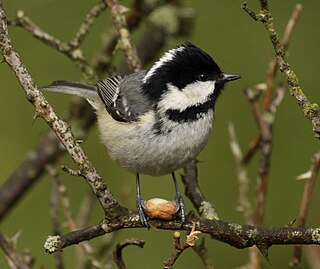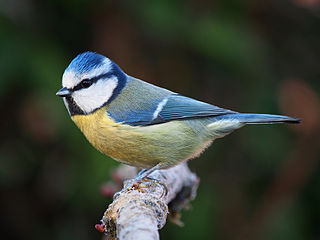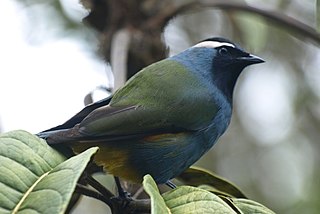
The bushtits or long-tailed tits, are a family, Aegithalidae, of small, drab passerine birds with moderately long tails. The family contains 13 species in three genera, all but one of which are found in Eurasia. Bushtits are active birds, moving almost constantly while they forage for insects in shrubs and trees. During non-breeding season, birds live in flocks of up to 50 individuals. Several bushtit species display cooperative breeding behavior, also called helpers at the nest.
TIT, Tit, Tits, or tit may refer to:

The tits, chickadees, and titmice constitute the Paridae, a large family of small passerine birds which occur mainly in the Northern Hemisphere and Africa. Most were formerly classified in the genus Parus.

The coal tit or cole tit,, is a small passerine bird in the tit family, Paridae. It is a widespread and common resident breeder in forests throughout the temperate to subtropical Palearctic, including North Africa. The black-crested tit is now usually included in this species.

The Eurasian blue tit is a small passerine bird in the tit family, Paridae. It is easily recognisable by its blue and yellow plumage and small size.

The great tit is a passerine bird in the tit family Paridae. It is a widespread and common species throughout Europe, the Middle East, Central Asia and east across the Palearctic to the Amur River, south to parts of North Africa where it is generally resident in any sort of woodland; most great tits do not migrate except in extremely harsh winters. Until 2005 this species was lumped with numerous other subspecies. DNA studies have shown these other subspecies to be distinct from the great tit and these have now been separated as two distinct species, the cinereous tit of southern Asia, and the Japanese tit of East Asia. The great tit remains the most widespread species in the genus Parus.

Azure is the color between cyan and blue on the spectrum of visible light. It is often described as the color of the sky on a clear day.

The azure tit is a passerine bird in the tit family Paridae. It is a widespread and common resident breeder throughout Russia and Central Asia and northwest China, Manchuria and Pakistan.

The painted berrypeckers, Paramythiidae, are a very small bird family restricted to the mountain forests of New Guinea. The family comprises three species in two genera: the tit berrypecker in Oreocharis, and the eastern crested berrypecker and western crested berrypecker in Paramythia. These are colourful medium-sized birds which feed on fruit and some insects. These species were formerly included in the Dicaeidae, but DNA–DNA hybridization studies showed these species were related to each other but distinct from the flowerpeckers. Some sources group painted berrypeckers as two genera belonging to the berrypecker family Melanocharitidae.

The African blue tit is a species of bird in the family Paridae. It is found in northern Africa and the Canary Islands. Its natural habitat is temperate forests. This species and the Eurasian blue tit were formerly considered conspecific. The status of this species has not been assessed because it is noted to be common on the islands of Tenerife and Gran Canaria. The species has been used in many research studies due to its island populations and relevance to evolutionary hypotheses.

The yellow-breasted tit is a bird in the family Paridae. It is found in Afghanistan, China, Kazakhstan, Kyrgyzstan, India, Pakistan, Russia, Tajikistan, Turkmenistan, and Uzbekistan. Its natural habitat is temperate forests.

The southern black tit or simply black tit is a species of bird in the tit family Paridae, which is native to woodland habitats in southern Africa.

Cyanistes is a genus of birds in the tit family Paridae. The genus was at one time considered as a subgenus of Parus. In 2005 an article describing a molecular phylogenetic study that had examined mitochondrial DNA sequences from members of the tit family, proposed that a number of subgenera including Cyanistes be elevated to genus status. This proposal was accepted by the International Ornithologists' Union and the British Ornithologists' Union.

The blue tit is a species of lycaenid or blue butterfly found in parts of South Asia and Southeast Asia. It was traditionally called Chliaria kina but the genus Chliaria is merged into Hypolycaena by many recent authors.
Lankesterella is a genus in the phylum Apicomplexa. Species in this genus infect amphibians, reptiles and birds.

The Aegean and Western Turkey sclerophyllous and mixed forests is an ecoregion in the lands around the Aegean Sea. The ecoregion covers most of mainland Greece, the Greek Aegean Islands, the western coast of Turkey, the southern Vardar river valley in North Macedonia, the southern Struma river valley at the extreme south-western corner of Bulgaria.
The anti-exhaustion hypothesis is a possible explanation for the existence of large repertoires and the song switching behaviour exhibited in birds. This hypothesis states that muscle exhaustion occurring due to repeating song bouts can be avoided by switching to a different song in the bird's repertoire. The anti-exhaustion hypothesis therefore predicts that birds with larger repertoires are less susceptible to exhaustion because they can readily change the song that they are producing.

Hanger Hill Wood is a small remnant of ancient woodland to the east of the Hanger Hill Park and North Circular Road at Hanger Lane, in Ealing in the London Borough of Ealing. Named from 'Hangra', the Old English word for wooded slope. There is access from Hanger Lane, alternative access is at several points on Chatsworth Road.













